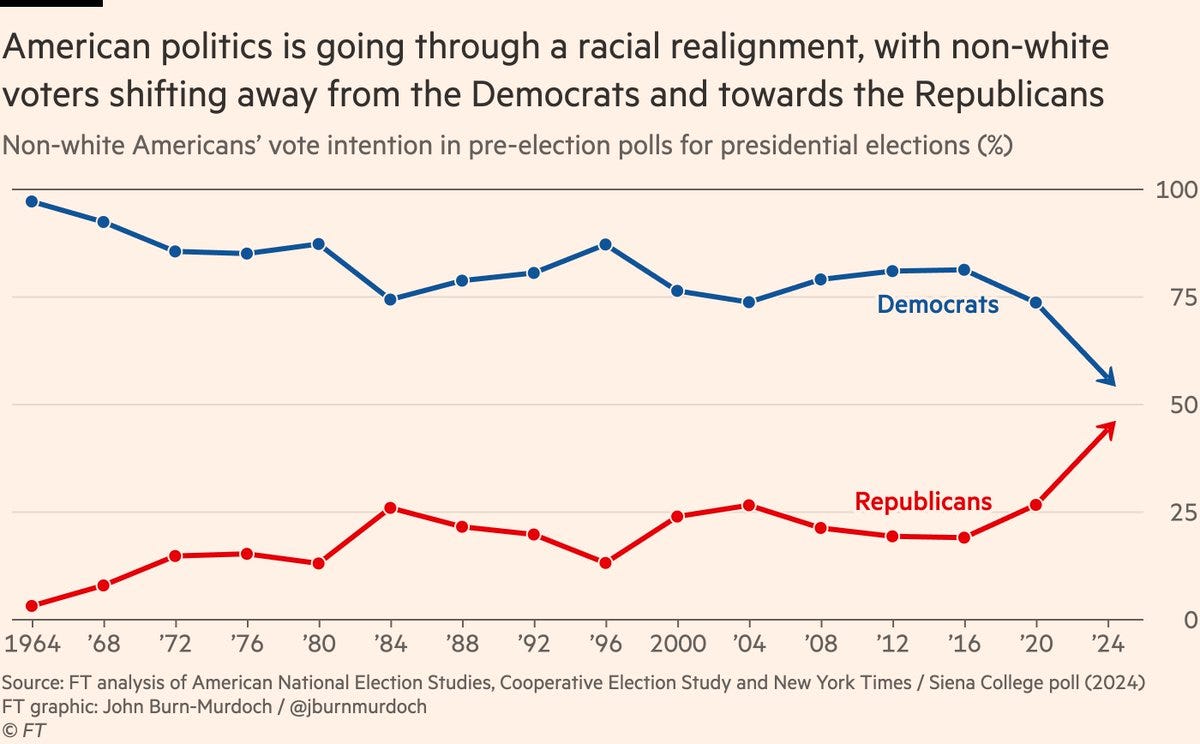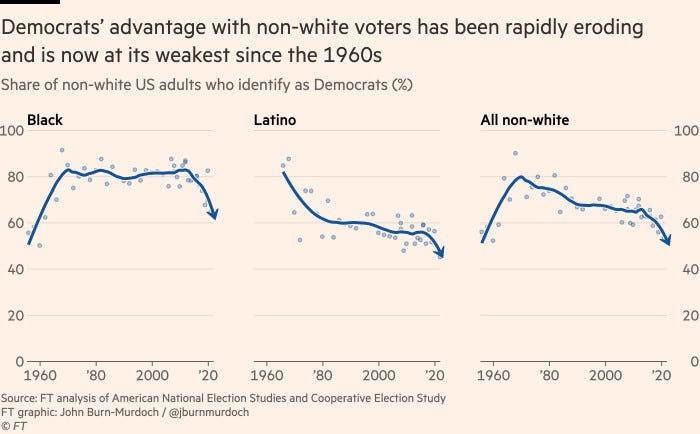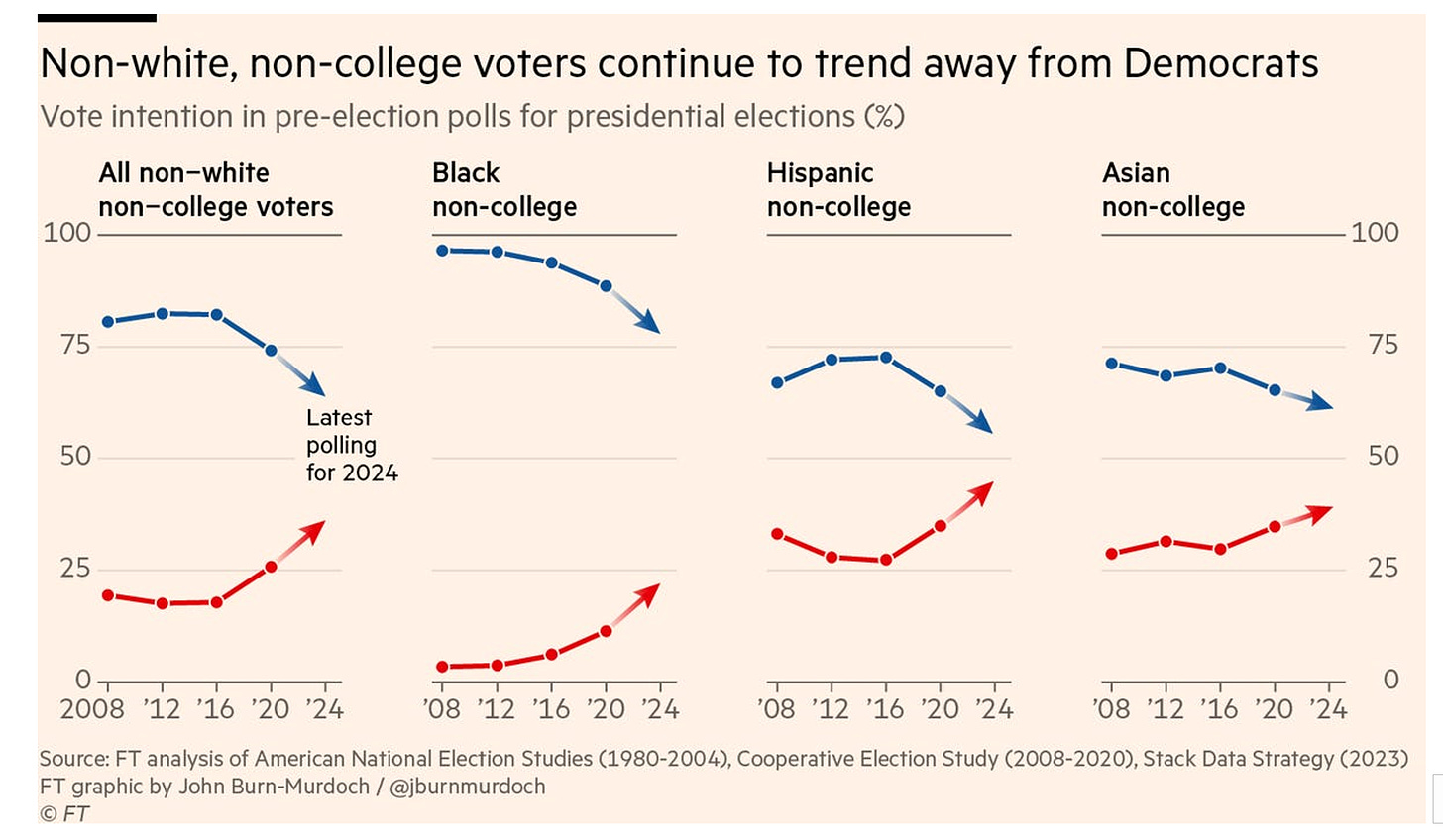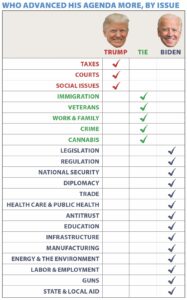Ronald Brownstein explains why “Why Biden’s fate may be settled in the Rust Belt not the Sun Belt” at CNN Politics: “The shift in expectations reflects the upside-down racial dynamics of the 2024 race,with most national and state polls showing Biden largely holding his 2020 support among White voters, while facing, at this point, unprecedented erosion among Black and Latino voters. Biden, as I wrote last year, is likewise maintaining his 2020 support better among older than younger voters. These surprising patterns have made the relatively older and Whiter three industrial blue wall states appear a better bet for Biden. That’s largely because his fate in them is less dependent on minority voters than in the younger and more diverse Sun Belt states that top his target list – Arizona, Georgia, Nevada and North Carolina….If Biden defends his 2020 victories in Michigan, Pennsylvania and Wisconsin – while also holding the single Electoral College vote he would gain by winning the Nebraska congressional district centered on Omaha – he would reach 270 Electoral College votes. That would be the case even if he loses Arizona, Nevada and Georgia, probably the three most vulnerable states among the 25 he carried last time, and fails to flip North Carolina, which narrowly backed Trump….James Carville, the veteran Democratic strategist, speaks for many in the party when he says that these Rust Belt states remain the indispensable building blocks of any Biden victory. “We used to say in 2020 it was Pennsylvania, Michigan and Wisconsin and everything else is lagniappe, which is a New Orleans term that means ‘a little something extra,’” Carville said….The issue environment is also pushing Democrats toward greater reliance on the Rust Belt states. Biden is heavily stressing his support for legal abortion, and while polls show broad support for that position across racial lines, many pollsters believe it resonates most powerfully as a voting issue among college-educated White voters, especially women. Conversely, economic issues loom largest for most non-white voters; that’s a difficult dynamic for Biden across the Sun Belt because polls consistently show widespread discontent with his management of the economy, including among many Black and Latino voters.”
Brownstein adds that “public polling shows Biden’s position is generally stronger in the Rust Belt. In most surveys, he’s running better in Pennsylvania and Wisconsin than in any battleground state; CNN’s latest Pennsylvania poll conducted by SSRS, for instance, showed him tied with Trump as did last week’s Wall Street Journal survey in Wisconsin….By contrast, polls consistently show Trump leading, often by around 5 points or more, in the big Sun Belt battlegrounds that Biden flipped in 2020 – Arizona and Georgia – as well as in North Carolina, which Biden hopes to put in play. Trump consistently leads more narrowly in polls of Nevada….In this configuration, Michigan is the potentially decisive outlier – a critical Rust Belt state where polls for months have showed Biden trailing….This general alignment upends the expectations of many political operatives and analysts, myself included, after Trump emerged as the GOP’s dominant figure in 2016. At that point, it appeared that Democrats would need gains in the Sun Belt battlegrounds to offset the possibility that Trump would lock in a GOP advantage in Rust Belt states crowded with the non-college-educated White voters who provided the cornerstone of his support….Since then, Democrats have indeed gained ground in the Sun Belt. When Trump took office, Democrats held just one of the six Senate seats in Arizona, Nevada and Georgia; now they control all six. (Although Arizona Sen. Kyrsten Sinema recently declared herself an independent after being elected as a Democrat in 2018, she still caucuses with the party.) In 2020, Biden carried all three states, becoming the first Democrat to win Georgia since 1992 and Arizona since 1996. North Carolina was the conspicuous exception to this brightening picture for Democrats: though the party won the governorship there in 2016 and 2020, Republicans have continued to notch narrow victories in presidential and US Senate races….The key to these Democratic Sun Belt gains have been the twin demographic forces reshaping the region. Democrats have significantly improved their performance in growing well-educated upper-middle-income communities across the Sun Belt including Cobb and Gwinnett counties outside Atlanta, the suburbs of Charlotte and Raleigh and suburban areas in Maricopa County around Phoenix.”
Brownstein notes further, “As important, the Sun Belt states have been racially diversifying at a far more rapid pace than the Rust Belt states. From 2004 to 2020, the share of the vote cast by people of color increased by 10 percentage points in Georgia and 15 points in Arizona, according to calculations from Census data by William Frey, a demographer at Brookings Metro, a nonpartisan think tank. By contrast, the non-White share of the vote increased over that same period by only about 6 points in Pennsylvania, 3.5 points in Michigan and 2 points in Wisconsin, Frey found….But that contrast means that Democrats rely on minority voters for a much larger share of their total vote in the Sun Belt states than they do in the Rust Belt battlegrounds. And that’s made them more vulnerable to the striking pattern in most public polls this year that has found Biden largely holding his 2020 support among White voters, but running well below his previous numbers among Black and particularly Latino voters. Trump is “clearly on offense among Blacks and Hispanics, especially among Black and Hispanic men,” said Jim McLaughlin, a pollster for the former president….The biggest question for Democrats in the Sun Belt states is whether they can push Trump off the beachheads he has established among minority voters. The Biden campaign points out that voters of color, especially Latinos in the southwest, often fully tune in later in the campaign. Biden is pursuing Black and Latino voters with unprecedented levels of targeted early media. These include ads in the Southwest that highlight Trump’s comments that immigrants are “poisoning the blood of our country,” and ads aimed at Black voters that charge Trump “stoked racial violence [and] attacked voting rights” over images of the Charlottesville, Virginia, march by White supremacists and the January 6, 2021, insurrection.”
In addition, Brownstrein argues, “Michigan, Pennsylvania and Wisconsin were all part of what I called, in 2009, the “blue wall.” Those were the 18 states that ultimately voted Democratic in all six presidential elections from Bill Clinton’s first win in 1992 to Barack Obama’s reelection in 2012. Trump’s success at knocking Michigan, Pennsylvania and Wisconsin out of the blue wall by a combined margin of about 78,000 votes was the key to his surprise victory in 2016….But since his victory, Democrats have regained the initiative in each state – at least until now. In 2018, Democrats won the governorship in all three, and reelected three Democratic senators. In 2020, Biden recaptured all three states. In 2022, Democrats again won the governorships in all three states, captured an open Senate seat in Pennsylvania, and won control of both state legislative chambers in Michigan and the state House in Pennsylvania. Last year, with strong support from state Democrats, the liberal candidate won a landslide victory in a Wisconsin State Supreme Court election that gave liberals a 4-3 majority on the body….In the 2022 governor races in the three key Rust Belt states, the Democrats maintained or exceeded Biden’s recovery with those working-class Whites, exit polls found. In 2024, the large number of blue-collar jobs flowing from the big three bills that Biden passed to promote more domestic manufacturing and infrastructure construction could help him maintain a competitive floor of support with these voters. “There are shovels going into the ground all over our state,” said Wisconsin Democratic Party chair Ben Wikler….Strong support for legalized abortion could allow Biden to run even better among college-educated White voters across the region in 2024 than he did in his first race. In 2022, the Democratic gubernatorial candidates in all three states exceeded Biden’s performance from two years earlier with both college-educated White men and women, the exit polls found….For Mark Graul, a veteran GOP consultant who ran George W. Bush’s 2004 campaign in Wisconsin, that history points toward the critical dynamic that will likely decide the state this year….Graul doesn’t think Trump can expand his advantage among non-college Whites further than he already has, partly because Biden can tout the blue-collar jobs tied to his big legislative achievements. “I think Trump really maxed that out,” Graul said. “I don’t know how you do much better than he did there.” If that’s right, the crucial question is whether Biden can notch enough gains among white-collar Whites in Wisconsin to offset a likely decline in his margin and/or turnout among Black voters and young people. “Things can change, but I think that dynamic is so baked in right now I don’t see it changing much,” Graul said.”….To offset losing Michigan, Biden would need a big Sun Belt breakthrough: winning either Georgia or North Carolina, or both Arizona and Nevada. None of that looks easy, which is why many Democrats view a Rust Belt sweep as the most plausible road to victory for Biden….If the president can defend those three states, “you are not going to lose,” said Carville. “And if you don’t do this you are going to have to catch an inside straight to win.”













